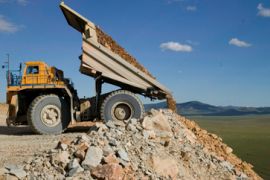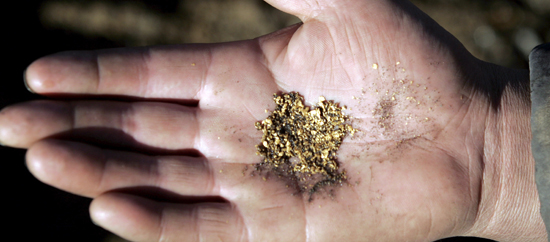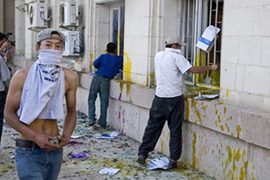The battle for Mongolia’s resources
Authorities struggle to balance the public’s demands with foreign investment.

 |
| Mongolia’s gold reserves are estimated to amount to 3,000 tonnes [EPA] |
Protests over allegations of election fraud in Ulan Bator have left the world worried about the stability of Mongolia’s democracy.
Nearly two decades after the grassland state gave up communism in favour of democratic reforms and capitalism, the government still struggles with corruption, misconduct by officials and a largely unregulated mining industry.
Keep reading
list of 4 itemsUS imposes new sanctions on Iran after attack on Israel
A flash flood and a quiet sale highlight India’s Sikkim’s hydro problems
Why is Germany maintaining economic ties with China?
Despite being one of the world’s poorest countries, Mongolia’s large reserves of natural resources have drawn increasing international interest alongside rising commodity prices and the rapid economic growth of China and India.
In more than 680 places in Mongolia, deposits of copper, gold, silver, iron ore, phosphor and zinc are hidden below the grassland. Up to 150 billion tonnes of high quality coal are said to be waiting to be mined.
Mongolia has the biggest known coal reserves in the world, the second largest reserves of uranium after Russia and one of the largest occurrences of silver. Its gold reserves are estimated to amount to 3,000 tonnes, copper reserves to over 30 million tonnes.
As the global fight for natural resources intensifies, Mongolia’s strategic importance is growing.
Struggling with poverty
How to regulate foreign participation in the mining sector has been a highly sensitive topic in Mongolia for years and has affected the recent elections.
Growing exploitation of resources helped to increase economic growth to nearly 10 per cent last year, but much of the population remains in poverty.
Tsakhia Elbegdorj, former prime minister of Mongolia, says the problems are two: “The first is poverty and the second is the problem, how to handle the enormous wealth.”
Another challenge is the battle for political and economic independence from big neighbours China and Russia.
Most of landlocked Mongolia’s agricultural products need to be imported as the Mongolian summer is short and temperatures are too low at other times of the year.
The country relies on imports of cheap products – because of a lack of local production – and needs foreign investments to build up its economy.
Mining is a major contributor to the economy, accounting for about 20 per cent of its GDP.
As of today, 40 per cent of the country has been opened for mining. The regulated mining sector employs over 12,000 people, while many more are engaged in unregulated mining.
More economic revenues are expected with the development of Oyu Tolgoi, an enormous copper deposit in the Gobi Desert, valued at $38bn.
Canadian mining company Ivanhoe has proposed a project to produce an average of more than one billion pounds of copper and 330,000 ounces of gold per year, for at least 35 years.
Exploitation fears
But with the Ivanhoe gold mine set to be one of the country’s largest mining project, Mongolia’s citizens, fearing growing foreign influence and environmental damage from mining, demanded the companies pay higher taxes.
In May 2006, demonstrators burned an effigy of Robert Friedland, owner of Ivanhoe mining, in protest against the proposed project.
 |
| Nineteen foreign firms were operating in Mongolia prior to the tax change [EPA] |
Parliament, reacting quickly, enacting a new windfall mining tax law allowing the government to impose taxes of 68 per cent on profits of gold when it exceeds $500 per ounce and copper over $2,600 per tonne.
Friedland had to start negotiations over the contract from scratch.
He demanded five per cent ownership of the Tavan-Tolgoi mine and larger amounts of coal assured in a stability pact that would be valid until 2015, but an agreement was never reached.
Until the protests in May 2006, the Mongolian government had been supportive of foreign-run mining companies.
Nineteen foreign companies had been operating in Mongolia prior to the tax change, many on very favourable terms.
In 1998, Centerra Gold, another Canadian mining company, had received full ownership of the Boroo Gold mine and a tax exemption for the first five years of exploitation. The company, which invested $75m, started production in 2004 and managed to mine 13 tonnes of gold in the first year.
In August 2007, the government reaffirmed the company’s rights to exploit, but changed the tax exemption agreement, demanding 25 per cent corporate income tax and a 5 per cent mineral royalty.
Despite getting the agreement signed, Centerra rescheduled an already planned construction of a gold mining facility in proximity to the existing Booroo Gold mine. Originally the company wanted to invest another $75m until 2009.
Many foreign companies pulled out or, as with Centerra, rescheduled their projects. Mongolian mining companies were also hit by the new legislation.
The immediate upshot of the new rules was a rise in the incidence of gold smuggling.
Gold rush
The amount of gold sold to Mongolia’s central bank, after the new tax was only half the gold sold to the central bank in 2005.
While the official export of gold dropped 13 per cent in 2006, increasing amounts of gold found its way over the border into China, hidden in coal trucks below a layer of coal.
In 2007, 10.5 tonnes of gold were sold to the central bank.
With many mining companies holding on to their gold to avoid paying the new tax and the increasing amount of gold leaving the country illegally, gold revenues that had helped to fund the Mongolian government fell short.
“The decision to [impose the tax] was not a hundred per cent right, but not a hundred per cent wrong as well,” Nambaryn Enkhbayar, the president, said in 2006.
“The regulation has not been helping much to improve the situation. You can not just change the rules for the private companies in the middle of the accounting year. I suggested to the parliament: if you really want the regulation, implement it on January 1 and inform the industry in advance, so they are prepared for it,” he said.
“That we didn’t do it that way scared many investors off – and justifiably so.”
While he could have stopped the law by veto, he said he felt this step would have been politically risky and that he wanted the Mongolians to participate in the mining profits.
“As an underdeveloped country we have to handle everything at the same time. The mining industry has to be linked with infrastructure projects; with the construction of better roads, railroads, houses and energy supply.”
Mineral wealth
In recent years the government has evolved from being predominantly the owner and operator of mines to being a regulator and this transformation required setting in place a legal framework.
 |
| Once protests die down, Mongolia may be able to revive its mining industry [EPA] |
“Most companies would hesitate to invest in any project not yielding an internal rate of return of at least 12 per cent,” James Otto, professor of mineral law and economics at the Colorado School of Mines, wrote in his report on the industry in 2007.
“The mine model analysis indicated that under the current Mongolian system the IRR [Internal Rate of Return] for the model mine would be about 8.6 per cent, thus not meeting the financial investment profitability criteria of all companies.
“Under the current system it is doubtful that any new major base metals mine could achieve a level of profitability that would be sufficient to meet the requirements of those lenders that finance mining projects.”
The government tried back-pedalling on the tax but parliament was not able to approve the changes by its final session before Monday’s elections.
The government drafted amendments to the nation’s minerals laws on gold, aimed at easing tax burden and to increase the volume of gold sold to the Central Bank of Mongolia.
Parliament also failed to approve the long-stalled Oyu Tolgoi project backed by Ivanhoe and multi-national mining company Rio Tinto.
The MPRP, which won the elections, has promised to tackle the issue and perhaps, once protests over their win have died down, Mongolia will be able to revive its stalled mining industry.